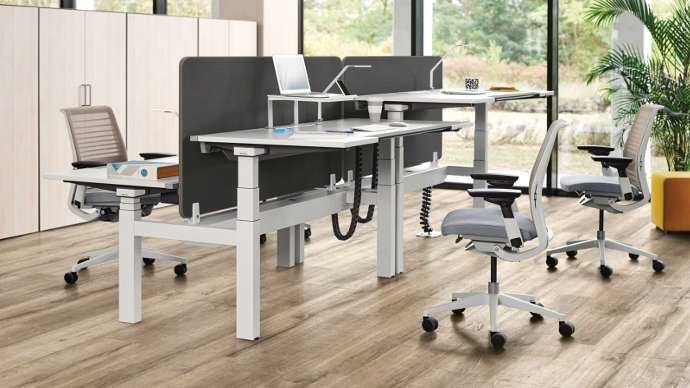Workplace design has become more and more focused on improving the working life of employees. In everything from workspace layout to furniture and the integration of technology, we are moving towards an era of ever more human-centred design.
In this new era, flexibility is key. The workplace should be a place that workers can adapt and flex to support their favourite modes of working or their mood at the time. A place that allows them to shift between the range of contemplative, collaborative and focused tasks that make up their working day.
Furniture solutions in these workspaces also need to be adaptable. According to a report by Public Health England:
“Allowing employees flexibility in office furniture and working stations is associated with reduced sickness absence and greater job satisfaction. The evidence suggests that it is important to consider ergonomics, including adjustable chairs and desks.”
More choice and control = happier employees
Supporting employees’ wellbeing is crucial for organisations in today’s competitive environment. And giving workers greater control over how and where they work plays a bit part in this.
Providing a comfortable workspace is essential for supporting employees’ physical wellbeing. Today’s workforce is diverse in age, gender, size and physical capabilities. Height-adjustable desks and chairs and moveable monitor arms all help fit the workspace to the user, maximising comfort and reducing the incidence of musculoskeletal complaints.

Having choice and control over the workspace also impacts employees’ mental and emotional health. The ability to step away from the buzz of the office into a quiet space for contemplation or focused tasks is important. These don’t necessarily need to be designated spaces or even pods or booths, but acoustic screens and barriers can be pulled in around a worker’s desk.
When people return to the office after Covid-19, they are likely to have their own idea of what ‘safe’ looks like. The option to use a desk away from others or add a screen or barrier to their workspace will help concerned employees to feel more comfortable.

Supporting workers to complete tasks
Workers need different spaces and solutions to help them be productive and do their best work. A flexible workspace means they can choose where they want to work based on what they need to get the job done. At times, they may need privacy and quiet. At other times, they may thrive off interaction and stimulation.
Agile teams, in particular, need to be able to move between different modes of work. They may need to be present in group meetings one moment, but then quickly split off to carry out detailed tasks in twos, threes or on their own. At times they’ll want to huddle at a table together and other times they’ll prefer to sit in a more relaxed, casual setting.

Teams need a dynamic space they can reconfigure to suit work flows throughout a project. The freedom to move furniture and materials around so they can physically engage with their content and gain new perspective helps teams be more productive. They need access to tools and equipment that can be pulled out quickly when needed and tucked away when not.
"The true agile working methodology is increasing, and it’s growing beyond the software engineering origin. Across all kinds of businesses, we’re seeing people hacking their space to suit how they want to work."
Flexible office furniture solutions
When it comes to furniture, the key is to provide as much adaptability and choice as possible, even within a single environment. Whether that’s a range of seating for people to choose from, adjustable desks or moveable screens and tools.
- Seating - Seating should be able to fit the widest possible range of users and adjust easily. Opt for task chairs with adjustable height, arms and lumbar support. Adjustments should be easy to reach from a seated position without straining. And throughout the workplace, it’s a good idea to have a variety of seating options so people can choose where best suits their task.
- Workstations – Height-adjustable desks have generated a lot of hype over the last few years. And for good reason. They give workers complete freedom to adjust their workspace throughout the day to suit their needs and improve comfort. Some come with tech integrations that make them even easier to adapt.
- Moveable furniture – Moveable screens, whiteboards and barriers enable workers to ‘hack’ the space for comfort and productivity. They can be brought to the forefront when required and hidden away when not.

Summary
The wellbeing of a diverse population of employees is at the forefront of workplace design. It was before the pandemic hit, and its even more of a priority now.
Ultimately, your office environment should be a space that people feel excited to work in. Not only is this vital for your employees’ wellbeing and personal fulfilment at work, but it is also critical to your organisation’s ability to thrive.









